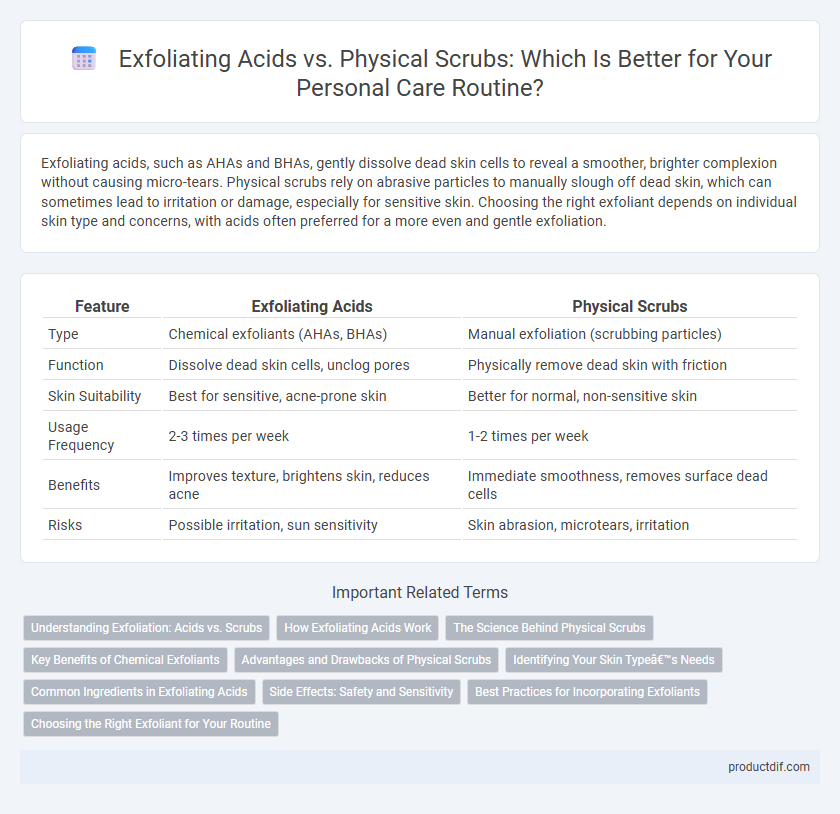Exfoliating acids, such as AHAs and BHAs, gently dissolve dead skin cells to reveal a smoother, brighter complexion without causing micro-tears. Physical scrubs rely on abrasive particles to manually slough off dead skin, which can sometimes lead to irritation or damage, especially for sensitive skin. Choosing the right exfoliant depends on individual skin type and concerns, with acids often preferred for a more even and gentle exfoliation.
Table of Comparison
| Feature | Exfoliating Acids | Physical Scrubs |
|---|---|---|
| Type | Chemical exfoliants (AHAs, BHAs) | Manual exfoliation (scrubbing particles) |
| Function | Dissolve dead skin cells, unclog pores | Physically remove dead skin with friction |
| Skin Suitability | Best for sensitive, acne-prone skin | Better for normal, non-sensitive skin |
| Usage Frequency | 2-3 times per week | 1-2 times per week |
| Benefits | Improves texture, brightens skin, reduces acne | Immediate smoothness, removes surface dead cells |
| Risks | Possible irritation, sun sensitivity | Skin abrasion, microtears, irritation |
Understanding Exfoliation: Acids vs. Scrubs
Exfoliating acids, such as alpha hydroxy acids (AHAs) and beta hydroxy acids (BHAs), chemically dissolve dead skin cells, promoting smoother texture and improved skin clarity. Physical scrubs use granules or beads to manually slough off dead skin, offering immediate tactile exfoliation but potentially causing microtears if overused. Choosing between chemical exfoliants and physical scrubs depends on skin sensitivity, with acids providing gentle, uniform exfoliation ideal for acne-prone or sensitive skin.
How Exfoliating Acids Work
Exfoliating acids such as alpha hydroxy acids (AHAs) and beta hydroxy acids (BHAs) work by chemically dissolving the bonds between dead skin cells, promoting gentle and even skin renewal without abrasive friction. These acids penetrate the upper layers of the skin to enhance cell turnover, improve texture, and reduce clogged pores, making them highly effective for sensitive and acne-prone skin types. Unlike physical scrubs that rely on granular particles to manually slough off dead skin, exfoliating acids provide a more uniform exfoliation with less risk of microtears or irritation.
The Science Behind Physical Scrubs
Physical scrubs work by mechanically removing dead skin cells through abrasive particles such as sugar, salt, or microbeads, promoting smoother and fresher skin. The granule size and shape affect the exfoliation efficacy and potential for skin irritation, with finer particles providing gentler abrasion. Scientific studies emphasize that overuse or aggressive scrubbing can compromise the skin barrier, leading to microtears and increased sensitivity.
Key Benefits of Chemical Exfoliants
Chemical exfoliants, such as alpha hydroxy acids (AHAs) and beta hydroxy acids (BHAs), offer deep pore cleansing and promote cell turnover without abrasive friction, reducing the risk of microtears and irritation common with physical scrubs. These acids effectively dissolve dead skin cells and enhance skin texture, improving hydration and brightness by stimulating collagen production. Their ability to target specific skin concerns like acne, hyperpigmentation, and uneven tone makes chemical exfoliants a versatile and gentle option for sensitive skin types.
Advantages and Drawbacks of Physical Scrubs
Physical scrubs offer immediate smoothness by manually sloughing off dead skin cells through abrasive ingredients like sugar, salt, or microbeads, providing instant exfoliation and improved circulation. However, their abrasive nature can cause micro-tears, irritation, and redness, especially for sensitive or acne-prone skin types, leading to potential damage with frequent use. Unlike exfoliating acids such as AHAs and BHAs, physical scrubs lack anti-inflammatory properties and may not promote cellular turnover as effectively.
Identifying Your Skin Type’s Needs
Exfoliating acids such as alpha hydroxy acids (AHAs) and beta hydroxy acids (BHAs) penetrate the skin to dissolve dead cells, making them ideal for oily or acne-prone skin by reducing congestion and promoting cell turnover. Physical scrubs use abrasive particles to manually remove dead skin, which may benefit resilient, normal skin but can exacerbate sensitivity or cause microtears in fragile or dry skin types. Understanding whether your skin is sensitive, oily, dry, or combination is crucial for selecting between chemical exfoliants and physical scrubs to achieve effective, safe exfoliation without irritation.
Common Ingredients in Exfoliating Acids
Exfoliating acids commonly include alpha hydroxy acids (AHAs) like glycolic acid and lactic acid, and beta hydroxy acids (BHAs) such as salicylic acid, which work by dissolving dead skin cells and promoting cell turnover. These chemical exfoliants offer gentle yet effective removal of dull surface skin without the abrasive action found in physical scrubs. Their ability to improve skin texture and clarity makes them a popular choice in personal care formulations targeting smooth, radiant skin.
Side Effects: Safety and Sensitivity
Exfoliating acids, such as alpha hydroxy acids (AHAs) and beta hydroxy acids (BHAs), offer controlled chemical exfoliation that minimizes microtears and irritation compared to physical scrubs containing abrasive particles. Physical scrubs can cause increased skin sensitivity, redness, and exacerbate conditions like acne or rosacea due to their mechanical friction. For sensitive or compromised skin, acid exfoliants typically provide a safer, more evenly distributed exfoliation with fewer side effects when used as directed.
Best Practices for Incorporating Exfoliants
Incorporate exfoliating acids such as alpha hydroxy acids (AHAs) or beta hydroxy acids (BHAs) by applying them to clean, dry skin one to three times per week to promote cell turnover and prevent irritation. Physical scrubs containing gentle particles like jojoba beads or finely ground oatmeal are best used sparingly, avoiding aggressive rubbing to reduce microtears and sensitivity. Always follow exfoliation with hydrating serums and broad-spectrum sunscreen to maintain skin barrier health and protect against UV damage.
Choosing the Right Exfoliant for Your Routine
Exfoliating acids like AHAs and BHAs dissolve dead skin cells chemically, promoting smoother texture and reducing acne, while physical scrubs rely on abrasive particles to manually slough off surface buildup. Sensitive or acne-prone skin benefits from gentle chemical exfoliants that minimize irritation and prevent microtears, whereas normal or oily skin types may tolerate physical scrubs with fine, non-irritating granules. Understanding your skin type and concerns is essential for selecting an exfoliant that enhances radiance without compromising barrier integrity or causing inflammation.
Exfoliating acids vs physical scrubs Infographic

 productdif.com
productdif.com